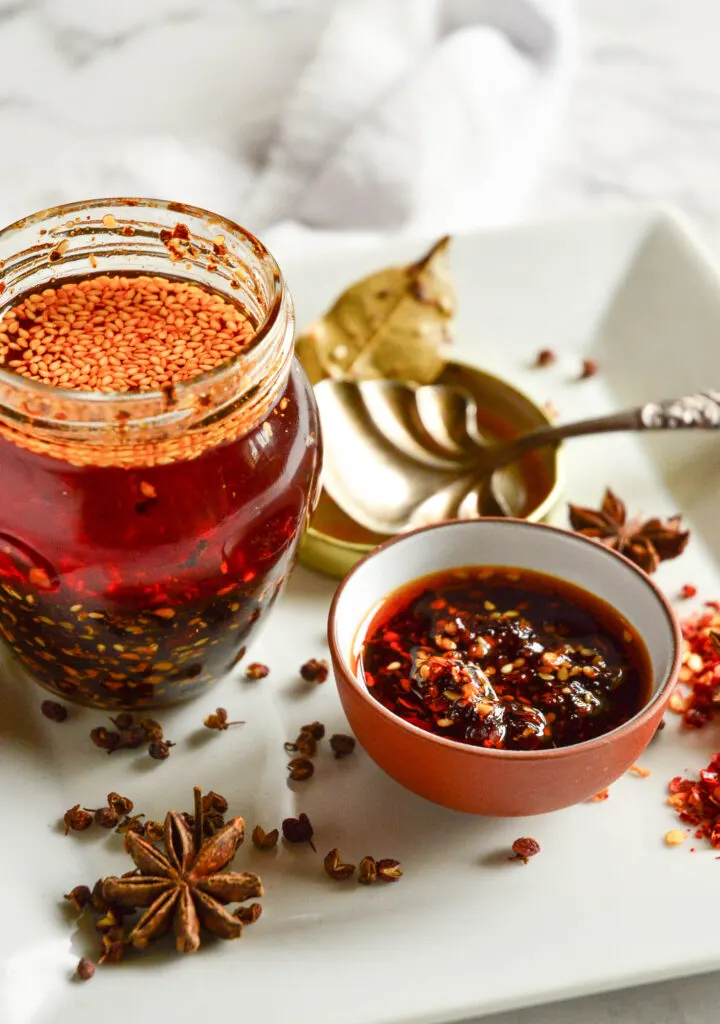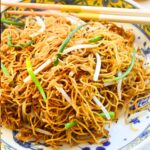I love this easy chow mein recipe. Perfect for nights when I don’t plan dinner ahead, I know I can always rely on this recipe as long as I have noodles in the pantry or freezer!
It’s not often I get to go out for dimsum but when I do, I love ordering noodles like this chow mein recipe.
Yes, you can find this iconic dish at Panda Express and can order it from any Chinese restaurant, but this recipe is so easy to make that you may want to do it yourself.
Though steamed rice is healthier, I prefer chow mein with almost anything.
This classic version is one I always make after going to my favorite Asian market, where I can choose from practically every noodle in the universe.
And yes, there are so many noodles! And each with their own intended use, that it can get confusing.
Chow mein is made with wheat noodles to which egg is added, but even though ramen noodles aren’t the same, they are often substituted.
When it comes to Chinese take-out, chow mein is often a star player, loved for its delicious combination of tender noodles and stir-fried veggies.
What exactly is chow mein, and how does it differ from its close cousin, lo mein?
Understanding the Basics: The Main Difference Between Lo Mein and Chow Mein
Both are popular Chinese noodle dishes, but the key distinction lies in their preparation.
Lo Mein: Lo mein noodles are typically soft, boiled, and then tossed with a variety of ingredients, resulting in a dish where the noodles absorb the flavors of the accompanying ingredients.
Lo mein translates to “tossed noodles” in Cantonese, and this dish often features a saucy, glossy finish.
Chow Mein: On the other hand, chow mein involves stir-fried noodles that are fried until they become crispy or dry.
Chow mein translates to “fried noodles” in Cantonese.
This chow mein recipe preparation gives chow mein its characteristic crunch, creating a delightful textural contrast to the savory sauce and tender-crisp vegetables.
A typical Panda Express chow mein contains celery, bean sprouts, green cabbage and onions or scallions or both!
Water chestnuts can also be added instead of celery. They give a great crunch to the finished dish!

What is Chow Mein?
Chow mein is a classic Chinese-American dish that has evolved into various regional styles.
At its core, chow mein is a stir-fried noodle dish typically made with a combination of crispy noodles, a savory sauce, and an array of vegetables and proteins.
I make mine vegetarian style, but one could easily add stir-fried chicken breast or chicken thighs, shrimp or pork, along with additional vegetables.
This chow mein recipe could easily become more of a main course rather than a side dish.
Chow Mein Ingredients:
Chow Mein Noodles: Chow mein noodles are the foundation of this dish. These are thin noodles that are boiled according to package directions and then pan-fried until somewhat golden brown, dry, and a little bit crispy. How crispy they become is up to you. I prefer them a bit soft, a bit dry and crispy.
I used a Hong Kong pan frying noodle but you could substitute spaghetti or thin egg noodles. It won’t be quite the same but it will still be great! You can find fresh noodles at Asian grocery stores or use dried noodles available at many supermarkets.
Yaki soba noodles are Japanese and do not contain egg. They could be substituted also, but just know they are not the same as a chow mein noodle.
Proteins: Chow mein can feature a variety of proteins, such as chicken, beef, pork, shrimp, or even tofu for a vegetarian option.
Vegetables: The vegetable component is up to you but could include a mix of red bell pepper, snap peas, bean sprouts, bok choy, napa cabbage, snow peas, water chestnuts, and more. The combination of vibrant colors and textures adds to the visual appeal and nutritional value of the dish.
Sauce Ingredients: The savory chow mein sauce is what ties everything together. Combine light soy sauce, dark soy sauce, oyster sauce, Chinese cooking wine (Shaoxing wine or dry sherry), sesame oil, and a touch of brown sugar or granulated sugar. Adjust the quantities to achieve the perfect balance of sweet, salty, and savory flavors. I use Pearl River soy sauce but Kikkoman is considered a light soy sauce, too. Dark soy sauce is thicker, darker and less salty.

- One tip I always find useful when making any Asian dish is to use the ingredients from the country of the recipe you are making. If making Japanese, use Japanese products. Same with Thai or Vietnamese. It makes the recipe taste more authentic.
How To Make This Chow Mein Recipe:
Step 1: Prepare the Noodles and the Vegetables
Boil the noodles according to the package instructions.
- Once cooked, drain and set aside.
- Rinse the bean sprouts in cold water and set aside. Julienne the scallions and separate the green parts from the white.
- If using cabbage, onion, celery or water chestnuts, have them ready to go.
Step 2: Make the Sauce:
There are many versions of sauce but mine contains light and dark soy sauce, sesame oil, oyster sauce, a pinch of salt and sugar, rice wine and a pinch of white pepper. Set aside.
Step 3: Stir-Fry the Vegetables (If Using)
- Heat vegetable oil in a large wok or large skillet over medium-high heat.
- Add the cabbage, onion, celery or water chestnuts and stir-fry until cooked but still crisp. Remove and set aside.
Step 4: Cook the Noodles:
- Heat wok over medium-high heat. It should not be smoking or you will burn the noodles! Add 1 tablespoon of oil and coat the wok or use a large non-stick or cast iron skillet. Spread the noodles in a single layer and crisp the bottom of the noodles, about 5 minutes. Flip the noodles and add another tablespoon of oil and let the other side crisp up. The noodles with become more dry than crisp. Set aside on a large plate or in a bowl.
Step 5: Combine and Stir-Fry
- Add the white part of the scallions to the wok with another tablespoon of oil. Cook briefly and then add back the noodles, tossing so they don’t remain clumpy! Now add the sauce and toss for a few minutes with the heat on medium-high, aiming for noodles to become more golden brown. Now add the bean sprouts and toss for about 1-2 minutes until they become transparent. They should still retain their crunch.
- Toss everything together, ensuring that the noodles are well coated in the flavorful sauce.
Step 6: Serve and Enjoy
- Once the noodles are evenly coated and heated through, remove the chow mein from the heat.
- Garnish with chopped green onions for freshness and a pop of color.

Tips for the Best Homemade Chow Mein:
- For the most authentic chow mein I used Hong Kong pan frying noodles that I boiled for 1 minute.
- If you want to add chicken or other protein just stir fry it first and then add it back for the final cook.
- Adjust the heat level by adding more black or white pepper to the sauce. Personally I find noodles Chow mein soothing and like it on the less peppery side. However a pinch of white pepper does add flavor but not really much heat. I do admit though that if I want more heat, I prefer chili oil!
- Serve immediately, though I must say even though the noodles on the dimsum cart aren’t always piping hot, they sure taste great!
This homemade chow mein recipe allows you to tailor the dish to your taste preferences.
It is a delicious recipe with primarily simple ingredients.
The key is achieving the perfect balance of textures and flavors, from the crispy noodles to the savory sauce and the crispy veggies.
With Chinese New Year upon us, I am hoping the Year of The Dragon brings only great things to everyone!

Hungry For More?

Want to add some spice to your chow mein? I love this chili oil!



This post contains affiliate links for which I may or may not be paid a small commission at no cost to you.
When perusing Amazon I came across this variety of Chinese ingredients that almost satisfies most any Chinese recipe. If you don’t live near a Chinese market you may want to check it out!
In my opinion though it is missing Sichuan peppercorns.
Print
Easy Chow Mein Recipe
- Prep Time: 15 Minutes
- Cook Time: 15 Minutes
- Total Time: 30 minutes
- Yield: 2 Servings 1x
- Category: Main Course
- Cuisine: Asian
Description
I love this easy chow mein recipe. Personally I often prefer it to rice!
Ingredients
8 oz thin Hong Kong Style Egg Noodle for Panfrying
3 t soy sauce
1 t dark soy sauce
1/2 t sesame oil
1 T oyster sauce
1/2 t sugar
1 T shaoxing rice wine
1/4 t ground white pepper
3 T + canola oil
4 scallions-julienned with white and green parts seperated
1 1/2 c bean sprouts
(optional- handful of green cabbage, sliced white onion, sliced garlic, protein such as chicken, shrimp or pork, sliced celery or water chestnuts)
Instructions
Bring 2 c of water to a boil. Cook noodles for 1 minute. Rinse in cold water and drain well.
Rinse bean sprouts in cold water and drain.
Julienne the scallions and separate the green parts from the white. Prepare other vegetables and protein if using.
Make sauce by combining both soy sauces, sesame oil, sugar, rice wine, white pepper and oyster sauce in a small measuring cup or bowl.
Heat wok or large skillet over medium-high heat and add a tablespoon of oil around the outside of the wok. Make sure the wok is well coated. Add the noodles and spread in an even layer. Cook the bottom of the noodles evenly until they become somewhat crisp and dry, about 5 minutes. Under any circumstance the skillet or wok should not be smoking or your noodles will burn. Flip and cook the other side, adding another tablespoon of oil around the outside. Tilt your skillet or wok so the oil creeps under the noodles. You may need to use more.
Once cooked, remove to a serving dish and set aside.
Place the wok back on the burner and add another tablespoon of oil. Add the white parts of the scallions and cook about 15 seconds. Then add the noodles back to the pan. Stir well and add the sauce and toss and stir for a few minutes until everything is well distributed. When the noodles are crisp to your liking, add the rest of the scallions and toss until they are almost cooked and then add the bean sprouts and cook until transparent but still crunchy.
Spoon back into the serving bowl and enjoy!
Notes
If you are using a protein, cook it first in a hot wok or skillet with oil. Remove and add in when the noodles are almost finished cooking.
If you are adding extra veggies stir them in after you have removed the chicken or other protein. When they are cooked remove them and add everything back in the final toss of the noodles.





